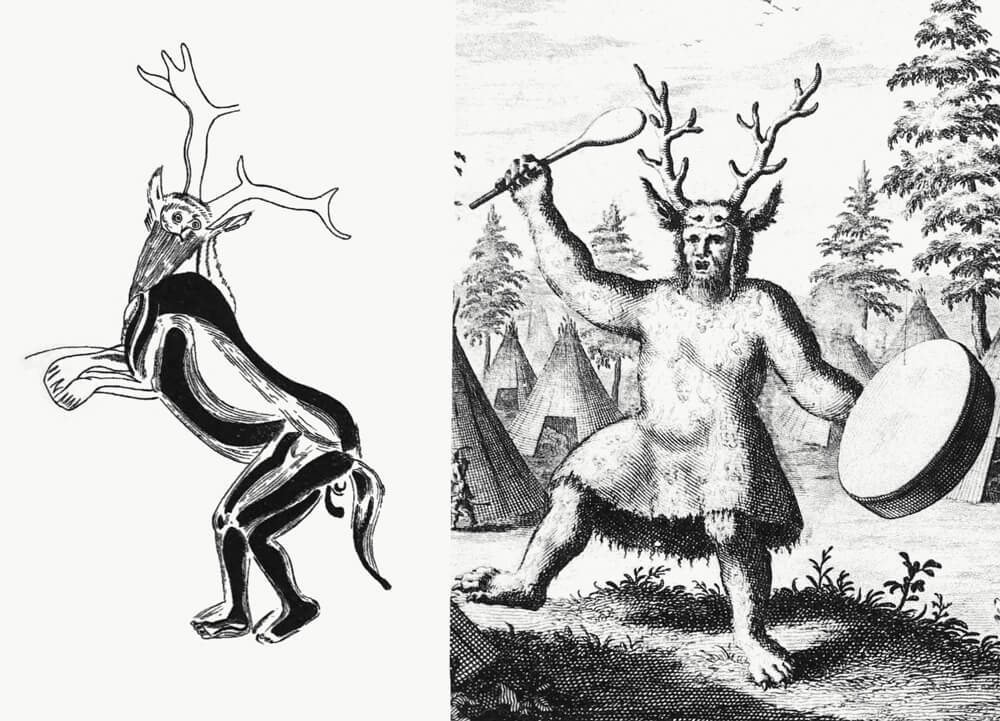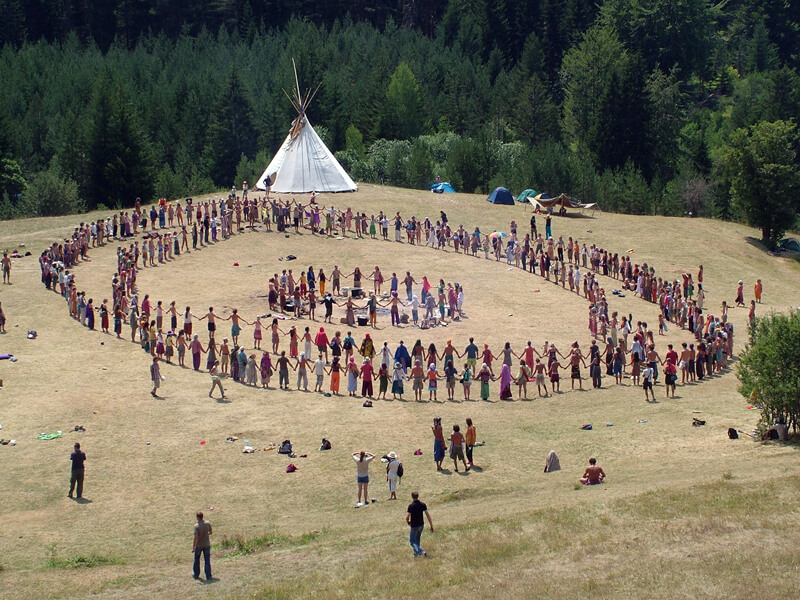Rituals (ritus inLatin = rite) have been the subject of much research since the beginning of the 20th century. They have been examined from the perspectives of anthropology, religious studies, social sciences and theatre research. The study of rituals is mostly multidisciplinary. In his Introduction to the Performing Arts,[1] the American director and theatre researcher Richard Schechner divides rituals into three (often intermingled) categories: social, religious and aesthetic. According to him, social rituals are also found in the animal kingdom (birds’ courtship display, how bees dance directions, etc.), while religious and aesthetic rituals are performed only by humans. It is difficult to estimate at what stage of development rituals became part of human life, but it is likely that at least social rituals were created before the development of spoken language.[2]
Speculation on the relationship between performance art and rituals began in the early 20th century in the Cambridge School. This group of anthropologists, following Charles Darwin’s 19th century ideas of natural science, studied the emergence of ancient theatre, taking an evolutionist approach to culture. They came to the conclusion that theatre had eventually evolved from simpler ritual forms. They considered ritualistic chorus dances as the roots of Greek classical drama. Such cultural evolutionism claims that culture has evolved from simple forms to more complex ones in much the same way throughout the world. This line of thought, like 19th century anthropology more broadly, is strongly Eurocentric.[3] Anthropologists strategies like used skull measurements to “demonstrate” White superiority over other “races.” Similarly, Western theatre was seen as the culmination of the evolution of the performing arts.
Debate on this topic has been going on for a long time among theatre scholars, and has led to a sprawling jungle of definitions. From the perspective of non-Western performance arts, the situation is different. In Asia, for example, countless forms of performance have clearly identifiable roots in ritual – and many forms of performance that are considered classical and therefore “advanced” may serve as rituals even today. For example, performing Japanese bugaku court dances is seen as maintaining cosmic balance. Many scholars today are inclined to abandon the sharp contrast between ritual and theatre, as different forms of performance can have very different histories.
In contrast, dance as an art form it is not strongly linked to language, so many of its forms can easily be classified as rituals. Dance has served, and in some cultures continues to serve, as prayer, thanksgiving, sacrifice and respect for astrological phenomena. Dance anthropology, which developed in the second half of the 20th century, sought to find forms of dance common to different cultures.[4] These include mating rituals familiar from the animal world (cf. birds’ courtship display), which in different cultures range widely from tribal events to wedding waltzes. “Warrior dances” include preparations for battle and forms of martial arts, while the circle dances that appear in many cultures often reflect the movements of celestial bodies and thus have a cosmic character.
A key dance type known throughout the world imitates the movements and expressions of animals.[5] Illustrations of them can be found in Stone Age caves around the world. The oldest ones are in Spain and France (c. 35 000–15 000 BCE). The caves are richly painted and carved with animal figures, including dancing human figures disguised as animals. They can be considered the oldest known images of dancing humans. According to current thinking, Stone Age caves served specifically as ritual sites.[6] There has been much speculation about the functions of early animal dances, and they have been suggested as magical performances to secure good luck in hunting. They may also have served as exercises to teach hunter-gatherers how to move without frightening their prey.

The fact that later shamans in many cultures dressed in animal skins and wore deer antlers as headdresses, strongly suggests magical ritual functions of animal dances. The term shaman, however, is of much later origin. Shamanism refers to a belief system centred on the shaman, who acted as an intermediary between the community and the supernatural. The shaman’s main characteristic is ecstatic ability to communicate, i.e. to use trance to communicate with spirits. The key area of shamanism has been considered to be Siberia, from where the shamanic zone has extended westwards to Lapland and eastwards to the Korean peninsula.[7]
Trance ritual and belief systems called shamanism are very widely known elsewhere. An extraordinary individual can act as a wise healer or fortune teller and perform sacrificial acts. There are many trance techniques besides dance, for example music at an accelerated tempo, hyperventilation and mind-altering substances (in Finland, red fly agaric or “fairy toadstools”). Some researchers believe that the phenomenon is linked specifically to shamanism in Siberia, but it seems more likely that cults of this kind are linked throughout the world to animistic belief systems that enliven nature.[8] This cognitive-psychological research approach is represented by David Lewis-Williams in The Mind in the Cave: Consciousness and the Origins of Art (2002).
Western dancers and choreographers became interested in ancient rituals in the early 20th century, when avant-garde artists systematically rebelled against 19th century traditions. Various attempts were made to discover the original roots of the culture, leading to a kind of primitivism.[9] For some artists, it meant a return to old ritual forms. In dance, the best-known example of neo-ritualistic primitivism is The Rite of Spring (1913), a collaboration between composer Igor Stravinsky, dancer-choreographer Vaslav Nijinsky and anthropologist-photographer Nicholas Roerich, on the theme of a shamanistic sacrificial ritual.
Around the same time, orientalist dancers such as Ruth St. Denis and Mata Hari were creating their own oriental rituals invented by themselves. These emerged in a cultural climate largely influenced by mysticism and the neo-spiritualist trends of the 19th century, such as theosophy, occultism and spiritualism.[10] However, only anthroposophy, developed by Rudolf Steiner, gave rise to its own dance genre, eurhythmy, at the beginning of the 20th century. By means of the free expressive dance of the era (Ausdruckstanz) it seeks to express the unity of body, spirit and soul through movement.

The neo-spiritual trends of the 1960s and 1970s have been lumped together under the term New Age. They include alternative medicine, forms of meditation, mini-cults created by neo-religions and a growing awareness of nature. The movement has given rise to many new forms of rituals. One example is the circular rituals at the turning points of the annual cycle of neo-Druidism, which is popular in the United Kingdom and the United States. These and many other New Age practices meet the criteria for rituals set by ritual studies, as the events are not performances for the public, but real events for participants who share a common understanding of reality. A contrast to such rituals is Nijinsky’s The Rite of Spring, in which a ritualistic performance is watched by a passive audience that knows the event to be fiction.
Since the 20th century turned to the pluralist 21st century, the boundaries of performance forms have been blurred. Many performances no longer reflect the traditional division between dance, theatre and musical theatre. The same applies to the categories of performance and ritual. With the emergence of more generalised community performances, the boundary between performers and spectators is blurred as the ritual nature of the event becomes more pronounced. In the sciences, the posthumanist turn and postcolonial critique of Eurocentrism have broadened our understanding of art, which seems to return performances and rituals to their earliest known roots.[11]
Notes
1 Schechner 2016, 110.
2 Along with Schechner, director Phillip B. Zarilli describes the importance of rituals in Performance and theatre in oral and writing cultures before 1700 (2010), 3–14.
3 Järvinen 2000, 25–26.
4 One of the earliest works in dance anthropology is To Dance is Human: A Theory of Nonverbal Communication by Judith Lynne Hanna, originally published in 1979.
5 e.g. Lonsdale 1981.
6 This view is argued by the strongly behavioural sciences-oriented archaeologist Yann-Pierre Montelle in his 2009 book Palaeoperformance: the emergence of theatricality as social practice. https://disco.teak.fi/esityspaikka/1-1-luolat-monitaiteellisina-esityspaikkoina/
7 Hoppál 2003.
8 Animism (“soul-belief”) is a term coined in the 1870s by early anthropologists in an attempt to define belief systems that predate the current dominant religions in different cultures. They are characterised by the worship and reverence of various nature elements such as animals, mountains, trees or rivers.
9 Innes 1993, 6–9.
10 New spirituality covers many spiritual movements since the Renaissance. Many of them emerged in the 19th century and are characterised by a critical approach to institutional religions and also esotericism, a belief in a hidden higher knowledge that can be accessed through initiation and/or from a more experienced leader.
11 Posthumanism seeks to update Renaissance humanism to reflect the current understanding of reality. In many respects, it criticises the ways in which human beings are separated from other living beings and the universe, but also, for example, from technology. Posthumanism includes a strong anti-ethical and anti-humanist tendency, glorifying the hard sciences, for whom transcendentalism means the pursuit of an immortal AI singularity. Postcolonialism explores colonialism and its consequences, including the way the European, White worldview presents itself as neutral.
Literature
Järvinen, Heli 2000. Samanistinen rituaali performanssina. Pro gradu thesis in theatre and drama studies. Tampere: Tampereen yliopisto. https://trepo.tuni.fi/bitstream/handle/10024/88288/gradu00044.pdf.
Hanna, Judith Lynne. (1979) 1989. To Dance is Human: A Theory of Nonverbal Communication, Chicago: The University of Chicago Press.
Hoppál, Mihály. 2003. Šamaanien maailma. Jyväskylä: Atena.
Innes, Christopher. 1993. Avant Garde Theatre: 1892–1992. London: Routledge.
Lewis-Williams, David. 2002. The Mind in the Cave: Conciousness and the Origins of Art. London: Thames and Hudson.
Lonsdale, Steven. 1981. Animals and the Origins of Dance. London: Thames and Hudson.
Montelle, Yann-Pierre. 2009. Palaeoperformance: the emergence of theatricality as social practice. London, New York, Calcutta: Seagull.
Nygaard, Jon. 2004. “Rock Art and Rock Sites as Indicators of Prehistoric Theatre and Ritual Performances.” In Günter Berghaus (ed.). New Perspectives on Prehistoric Art. Westport, Connecticut, London: Praeger.
Schechner, Richard. 2006. Performance Studies: an introduction. New York: Routledge. (Published in Finnish in 2016 as Johdatus esitystutkimukseen. Teatterikorkeakoulun julkaisusarja 48. Helsinki.)
Zarrilli, Phillip B. 2010. “Oral, ritual and shamanistic performance.” In Gary Jay Williams (ed.). Theatre Histories: An Introduction, New York, London: Routledge.
Contributor
Jukka O. Miettinen
Jukka O. Miettinen (PhD in dance) has taught art and theatre history at several universities and art colleges in Finland and Thailand. He has worked as a lecturer of performing arts at the University of the Arts Theatre Academy. He has been a dance critic for Helsingin Sanomat since 1980 and has published several books and articles in Finnish and English. He has been the artistic director of the Kuopio Dance Festival and the Asia in Helsinki Festival.